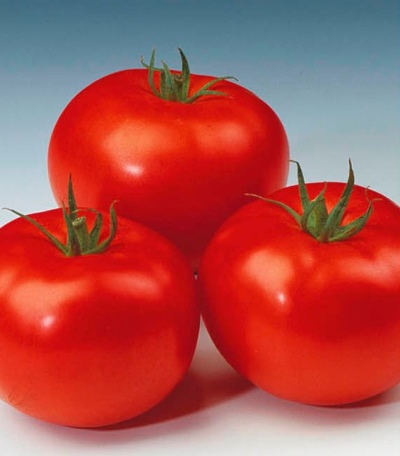
- Authors: Popova L.N., Arinina L.P.
- Year of approval: 2001
- Category: grade
- Growth type: determinant
- Appointment: fresh consumption, for juice, for ketchup and tomato paste
- Ripening period: mid-season
- Ripening time, days: 112-116
- Growing conditions: for open ground
- Marketability: high
- Transportability: Yes
The creators of the Gift tomato seem to hint that it will be a good purchase for any farmer. But not everything is so simple, and such a culture also needs to be dealt with closely. In the right hands, such a variety will bring a lot of benefits.
Breeding history
The developers of the Gift variety are the breeders L.N. Popova and L.P. Arinina. The culture was entered into the State Register of Russia in 2001. It is, indeed, a classic variety, not a hybrid.
Description of the variety
The gift tomato on the beds shows all the features of determinant growth. It can be grown mainly in the open field. Bushes are undersized and usually reach 0.6-0.7 m. The number of leaves is relatively large. The leaves themselves are moderately large and have a simple green color.
The main qualities of the fruit
Such a culture is distinguished by excellent marketability. Initially, the tomato has a plain green color. When it develops and gains the necessary ripeness, it will turn red. The berries will be large, on average they weigh 114-120 g. They are characterized by a rounded configuration and development from a simple inflorescence.
Other parameters:
laying of the very first inflorescence above 8-9 leaves;
the formation of subsequent inflorescences every 1-2 leaves;
peduncles without characteristic articulations;
a decent level of keeping quality.
Taste characteristics
Descriptions of the Gift Tomato mention its sweetness. But one cannot ignore the fact that it is harmoniously intertwined with a sour note. The taste still has a good saturation, which is liked by almost all consumers. The taste will become especially rich if the plant is cultivated in a greenhouse.
Ripening and fruiting
Such a tomato belongs to the mid-season category. Under normal conditions, it will ripen in 112-116 days. Traditionally, the countdown is no longer from planting, but from the appearance of the earliest green shoots. Most often, the harvest takes place between July 15 and August 20.
Yield
The declared ability to collect from 3.1 to 5.2 kg of berries per 1 sq. m. It largely depends on the region of cultivation and on what the actual weather is. However, achievements and miscalculations in agricultural technology often affect productivity almost more than the objective situation.
The timing of planting seedlings and planting in the ground
Sowing seeds in containers is recommended in the last decade of March. With normal full development of seedlings, it will be possible to get strong seedlings by May 10-20. However, in specific years, meteorological conditions and other parameters can significantly affect the result.

Growing tomato seedlings is an extremely important process, because it largely depends on whether the gardener can harvest at all. All aspects must be taken into account, from seedbed preparation to planting in the ground.
Landing scheme
Summer residents have a good choice. Most often, this culture is planted according to the 700x300 mm system. But the 700x400mm approach is also a good choice. There is simply no point in looking for any other options.

Growing and caring
The variety is not very susceptible to fruit cracking. However, it is best to avoid waterlogging so that it does not occur. The heat resistance of the Gift also does not mean that you can give up caring in hot dry weather.
The soil for containers for seedlings must be taken fertile, even better with additional fertilization. Covering the container with a film helps to increase germination even more.
When the first shoots appear, the film is immediately removed. A pick is made when the first two leaves appear. For Gift it is best to use light loam. In the garden for this variety, it is necessary to allocate areas protected from drafts. It is necessary to remove excess leaves at the 2nd month of development in the open field. They do this weekly, removing no more than 3 sheets each time.
It is necessary to water the bushes strictly in the evening and only with settled water. Watering occurs approximately once a week. You will need to ensure that water does not fall on the green parts of the plant and there is no waterlogging. Loosening is carried out at least weekly. It will also need to be done as the earth is compacted (in addition to the normal schedule).
Recommended fertilizers:
complex mineral compositions;
cow dung;
bird droppings.




A plant needs different micronutrients at each stage of growth. All fertilizers can be divided into two groups: mineral and organic. Folk remedies are often used: iodine, yeast, bird droppings, eggshells.
It is important to observe the rate and period of feeding. This also applies to folk remedies and organic fertilizers.


Growing regions
The Gift variety was officially released for:
Western Siberia;
Eastern Siberia;
The Far East;
the Ural and North Caucasian regions;
Volga region;
Moscow region;
Leningrad region;
Karelia;
Arkhangelsk, Murmansk, Tver regions;
Belgorod, Kursk, Voronezh, Lipetsk, Tambov regions.
Review overview
Cultivating a tomato gift is not too burdensome. More delicious fruits are obtained in the beds than in greenhouses. The berries are beautiful and have the same geometry. There are no complaints about the variety. But with prolonged cultivation in bright sun, part of the crop is likely to crack.

























































































